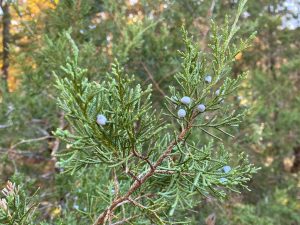 By Brenna Thompson, Land Protection Manager East
By Brenna Thompson, Land Protection Manager East
Eastern Redcedar (Juniperus virginiana)
The beginning of winter is a time of austerity in Piedmont forests, and when all the showy leaves and flowers have faded and fallen we are left with more subtle features to enjoy. This is the time when the eastern redcedar really shines.
Eastern redcedar is a medium-sized evergreen with blue/green scale-like foliage, red pealing bark, and the female trees have a wealth of pale blue “berries” that are actually tiny cones. The common name of this tree is a misnomer since they are actually a juniper not a cedar, but they are not the same juniper whose berries are used to give gin its distinctive flavor. These berries are an important food source for many mammals and birds and are especially beloved by Cedar Waxwings, whose name is derived from how frequently they are seen eating cedar berries in the winter months. Its dense foliage also makes it a favorite nesting and roosting tree for birds.
The eastern redcedar is in the cypress family, and it’s highly rot-resistant wood was once used to make rail fences, cabins, and all kinds of furniture. It was particularly prized for storage chests and wardrobes due to its vibrant red heartwood and its aromatic scent, which gives linens a lovely smell and also repels moths and other insects.
These trees are relatively slow growing and long lived, with the potential to live over 450 years. They are the most widely distributed conifer in the eastern US, and often grow in old abandoned farmland like that found on TLC’s Horton Grove Nature Preserve in north Durham County. You can find them scattered around Horton Grove on the edges of the meadow, and even growing in the shadow of massive oaks and yellow poplars on trails like the Justice Loop.
Protect the Eastern Redcedar by contributing a gift to TLC.
